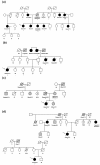A PALB2 mutation associated with high risk of breast cancer
- PMID: 21182766
- PMCID: PMC3046454
- DOI: 10.1186/bcr2796
A PALB2 mutation associated with high risk of breast cancer
Abstract
Ntroduction: As a group, women who carry germline mutations in partner and localizer of breast cancer 2 susceptibility protein (PALB2) are at increased risk of breast cancer. Little is known about by how much or whether risk differs by mutation or family history, owing to the paucity of studies of cases unselected for family history.
Methods: We screened 1,403 case probands for PALB2 mutations in a population-based study of Australian women with invasive breast cancer stratified by age at onset. The age-specific risk of breast cancer was estimated from the cancer histories of first- and second-degree relatives of mutation-carrying probands using a modified segregation analysis that included a polygenic modifier and was conditioned on the carrier case proband. Further screening for PALB2 c.3113G > A (W1038X) was conducted for 779 families with multiple cases of breast cancer ascertained through family cancer clinics in Australia and New Zealand and 764 population-based controls.
Results: We found five independent case probands in the population-based sample with the protein-truncating mutation PALB2 c.3113G > A (W1038X); 2 of 695 were diagnosed before age 40 years and 3 of 708 were diagnosed when between ages 40 and 59 years. Both of the two early-onset carrier case probands had very strong family histories of breast cancer. Further testing found that the mutation segregated with breast cancer in these families. No c.3113G > A (W1038X) carriers were found in 764 population-based unaffected controls. The hazard ratio was estimated to be 30.1 (95% confidence interval (CI), 7.5 to 120; P < 0.0001), and the corresponding cumulative risk estimates were 49% (95% CI, 15 to 93) to age 50 and 91% (95% CI, 44 to 100) to age 70. We found another eight families carrying this mutation in 779 families with multiple cases of breast cancer ascertained through family cancer clinics.
Conclusions: The PALB2 c.3113G > A mutation appears to be associated with substantial risks of breast cancer that are of clinical relevance.
Figures




References
-
- Renwick A, Thompson D, Seal S, Kelly P, Chagtai T, Ahmed M, North B, Jayatilake H, Barfoot R, Spanova K, McGuffog L, Evans DG, Eccles D. Breast Cancer Susceptibility Collaboration (UK) Easton DF, Stratton MR, Rahman N. ATM mutations that cause ataxia-telangiectasia are breast cancer susceptibility alleles. Nat Genet. 2006;38:873–875. doi: 10.1038/ng1837. - DOI - PubMed
-
- Seal S, Thompson D, Renwick A, Elliott A, Kelly P, Barfoot R, Chagtai T, Jayatilake H, Ahmed M, Spanova K, North B, McGuffog L, Evans DG, Eccles D. Breast Cancer Susceptibility Collaboration (UK) Easton DF, Stratton MR, Rahman N. Truncating mutations in the Fanconi anemia J gene BRIP1 are low-penetrance breast cancer susceptibility alleles. Nat Genet. 2006;38:1239–1241. doi: 10.1038/ng1902. - DOI - PubMed
-
- Rahman N, Seal S, Thompson D, Kelly P, Renwick A, Elliott A, Reid S, Spanova K, Barfoot R, Chagtai T, Jayatilake H, McGuffog L, Hanks S, Evans DG, Eccles D. Breast Cancer Susceptibility Collaboration (UK) Easton DF, Stratton MR. PALB2, which encodes a BRCA2-interacting protein, is a breast cancer susceptibility gene. Nat Genet. 2007;39:165–167. doi: 10.1038/ng1959. - DOI - PMC - PubMed
Publication types
MeSH terms
Substances
Grants and funding
LinkOut - more resources
Full Text Sources
Medical
Molecular Biology Databases
Research Materials
Miscellaneous

